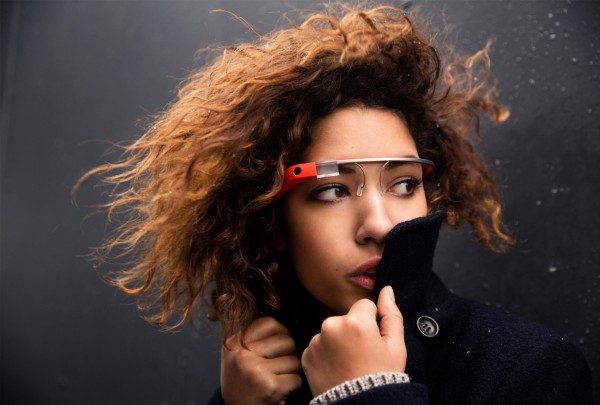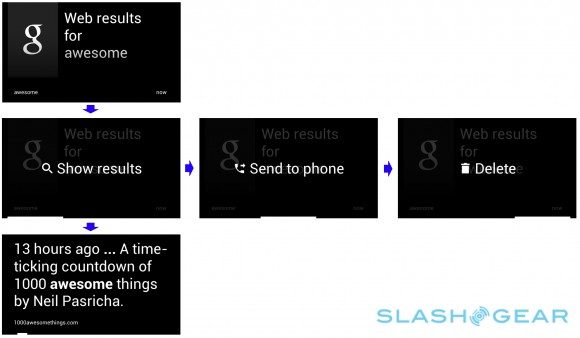Google Glass could be the first product to take augmented reality into the mainstream. The forthcoming minimal head mounted display promises to make our interaction with technology more seamless and natural. There are many who will welcome it. There are many who will hate it. Regardless of which side you’re on, we’re synthesizing everything we’ve learned after months of following every bit of Google Glass news.
Despite a recent deluge of Google Glass news, the company has been extremely quiet regarding Glass specs. There are still big gaps in our knowledge of the device. However, there have been hints to glean along the way for those paying attention.
First I’ll start by painting the clearest technical picture of Google Glass specs from the available information:
Google Glass Specs
- Display: 640×360 resolution (13)
- Appears to use a temple-mounted projection in combination with a prism/waveguide. Field of view is likely no higher than 15 degrees. Display appears in the top right of your vision as a transparent color image (1).
- Processor and RAM: Dual-core OMAP processor (13)
- Likely an ARM processor such as those available in modern smartphones. 1GB of RAM is my best guess based on space restrictions.
- Battery Life: Unspecified battery
- Unless Google has struck some major battery breakthrough, expect 2-4 hours of continuous display usage, less if recording video, using WiFi, or taking photos (2).
- Connectivity: WiFi, Bluetooth, and GPS on-board, but no 3G or 4G for cellular data (1)
- Glass can tether to iPhone, Android, and other devices for data.
- Software: Based on Android 4.0 (13), Glass OS?
- Controls: Touchpad on the side, a physical button, and voice commands (1)
- “Ok Glass…” is used to start command phrases. Touchpad must be tapped to start Glass listening for command phrases and can also be tapped to make selections. Gestures on the touchpad allow you to swipe left or right to slide through lists or down to go back. Tilting your head up slowly will also prompt Google Glass to start listening for voice commands (13).
- Sensors: Gyroscope, magnetometer, and accelerometer (13)(3)
- One unidentified sensor rests on the inside of the projection arm, near the eye (10). An anonymous source tells us that it is neither a camera for eye-tracking or a proximity sensor to detect when glass is worn. However, SlashGear says they have a source “close to the Glass project” that says it is indeed an infrared eye-tracking camera (13). We’re still lacking corroboration on that front though.
- Ports: MicroUSB seems to be the only port on Google Glass(4)
- Makes us wonder how Glass will charge, maybe it’ll use inductive charging? If a MicroUSB port is present it could have support for MHL which would provide HDMI output.
- Camera: 3.1MP CMOS camera, focal length 2.8 mm, f/2.4 aperture (5), front-facing microphone appears to be just beneath the camera (11).
- Technically capable of 1080p video but we’ve only ever seen 720p video from Google Glass, likely due to hardware restrictions (6).
- Weight: ~36 grams (7)
Google Glass Frames, Lenses, and Colors
Google has shown a number of frame and lens styles for Google Glass.
Lenses:
Frames:
Google says that the latest version of Glass has a screw that allows you to remove the frame and swap it out for a new one (1). At the moment they won’t say if they’re naming any partners that will be making frames, but the New York Times says that the company is in negotiations with Warby Parker on Google Glass frames (12).
Previously we’ve seen a prescription lens Google Glass prototype with traditional frames at Google IO 2012:
Colors:
As for the Glass unit itself, Google has showed off a variety of colors including Charcoal (black), Tangerine (orange), Shale (grey), Cotton (white), and Sky (blue) (10):
Waterproof Google Glass?
One picture we dug up shows someone using Google Glass covered in water droplets… will the unit be water resistant?
Google Glass Features
What can Google Glass do? The most recent video, ‘How it Feels Through Glass’, gives us a glimpse of what Google Glass features we can expect. The company says that the entire video was filmed using the Google glasses. Though the overlay that you see is added in post-production, it is true to what Google Glass can do and how it works, according to Joshua Topolsky’s time using Glass (1):
Elsewhere we have heard and seen what Glass can do; here’s a list:
- Take pictures
- Send photos
- Record video
- Make phone calls
- Show the time
- Show weather
- Flight status notifications (possibly a subset of Google Now functionality)
- Arrival and destination airports
- Airline
- Flight number
- Departure time
- On time/delay status
- Terminal
- Gate
- Search Google
- Images
- Translation
- Search results that appear to come from Google’s Knowledge Graph, which includes tons of useful info like real time sports scores, unit conversions, bios on people, info snippets on objects, forthcoming holidays, etc.
- Stream video via Google Plus Hangout
- Dictate text
- Notifications
- Send SMS
- Get directions vis Google Maps
- Driving
- Biking
- Walking
Google Glass Interface / Google Glass OS
SlashGear has a source “close to the Glass project” which has shared what appear to be official images from the Google Glass interface (13):
They describe the Google Glass UI:
In a sense, Glass has most in common with Google Now. Like that service on Android phones, Glass can pull in content from all manner of places, formatted into individual cards. Content from third-party developers will be small chunks of HTML, for instance, with Google’s servers supporting the various services that Glass users can take advantage of.
Some of the cards refer to local services or hardware, and a dog-ear folded corner indicates there are sub-cards you can navigate through. The most obvious use of this is in the Settings menu, which starts off with an indication of battery status and connectivity type, then allows you to dig down into menus to pair with, and forget, WiFi networks, toggle Bluetooth on or off, see battery percentage and charge status, view free storage capacity and firmware status (as well as reset the headset to factory settings), and mange the angle-controlled wake-up system.
In effect, each card is an application. So, if you ask Glass to perform a Google search – using the same server-based voice recognition service as offered on Android phones – you get a side-scrolling gallery of results cards which can be navigated by side swiping on the touchpad. It’s also possible to send one of those results to your phone, for navigating on a larger display.
Google Glass Price
 The first opportunity that the public had to pre-order Google Glass was a Google I/O 2012. U.S. based attendees were able to pre-order the ‘Explorer Edition’ of Glass for $1500 (8).
The first opportunity that the public had to pre-order Google Glass was a Google I/O 2012. U.S. based attendees were able to pre-order the ‘Explorer Edition’ of Glass for $1500 (8).
In the last week, Google announced the #ifihadglass campaign where people could submit short responses to the hashtag in order to have the opportunity to pre-order Google Glass, which would also cost $1500.
The Google Glass price will be “less than $1500” when it launches, according to The Verge (14).
But of course we knew that… Google Glass product director Steve Lee says that they expect millions of people to use Glass (1); that won’t happen if they want $1500 for each pair of Google glasses.
So from here we have only speculation. My best guess is that you will be able to buy Google Glass for $500 when it first launches, but I’m really hoping that Google can trim that figure down to $200 for widespread availability.
$500 is going to be a hard sell as a mere addon for a smartphone — after all you’ll need one to tether a data connection to use most Google Glass features. $200 would of course still be expensive, but not much more than some would expect to pay for a nice pair of sunglasses.
There’s no official word on how many pre-orders were placed at Google I/O 2012 or how many people will be accepted into the Explorer program through the #ifihadglass campaign. Around 6000 people attended Google I/O 2012 and pre-orders were restricted to U.S. attendees only. My best guess for total Google Glass pre-orders from I/O 2012 is around 2000 units.
Google Glass Release Date

The company says that they expect the Google Glass release date to be before the end of 2013. That leaves up to 10 months for the team to continue to refine Glass before launch.
While Google IO 2013 would be a great place to launch, I don’t think the company will be ready to let people buy Google Glass as IO 2013 is only three months away. You should expect to hear more about Google Glass at IO 2013 though — maybe that’s when they’ll launch the Explorer Edition of Glass?
The holiday season is a better guess for the Google Glass release date; it gives them more time to work on the unit and is a popular time for smartphone sales and accessories like glasses!
Sources:
- The Verge — I used Google Glass: the future, but with monthly updates
- Based on comparable hardware from Vuzix: http://www.vuzix.com/consumer/products_m100.html#specifications
- YouTube — How it Feels [through Glass]
- Geek.com — How sound works on Google’s Project Glass
- Google Plus — Pictures taken with Google Glass
- YouTube — Google Glass Jumping on Trampoline
- Based on Glass lead designer Isabelle Olsson saying that Glass “weighs less on your nose than many sunglasses” at Google IO 2012: https://www.youtube.com/watch?v=O3wiLZWOIi8
- Road to VR — The Latest on Google Glass: Early Technical Details, Pre-order Units Made Available to I/O Attendees for $1500
- Road to VR — Google Glass with Prescription Lenses Spotted in the Wild in NYC
- Road to VR — New Google Glass Pictures Reveal Hidden Sensor
- The Verge — Orange Google Glass Unit
- New York Times — Google Searches for Style
- SlashGear — Google Glass in focus: UI, Apps & More
- The Verge — Google aims to sell Glass to consumers this year for less than $1,500

















